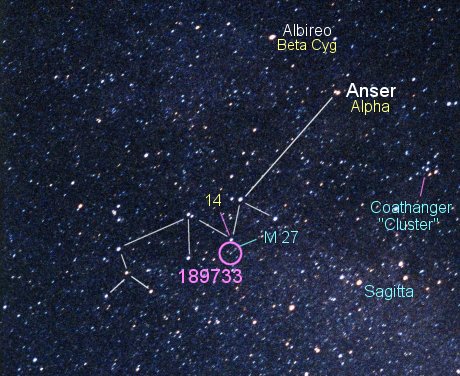 A Jupiter-like planet in short orbit about the eighth magnitude K
dwarf HD 189733 (63 light years away) is also seen to transit
across the star, allowing the orbital tilt, exact planetary mass,
density, and something of the chemistry to be found.
A Jupiter-like planet in short orbit about the eighth magnitude K
dwarf HD 189733 (63 light years away) is also seen to transit
across the star, allowing the orbital tilt, exact planetary mass,
density, and something of the chemistry to be found.
THE PLANET
The class K1.5 dwarf star HD 189733, found in the constellation Vulpecula, lies at the center of the circle
just a bit southeast of 14 Vul. (The planetary nebula M 27 is at the
circle's upper-right edge.) The planet orbits the star in a
circular path at a very small distance of 0.031 Astronomical Units,
just 10 percent Mercury's distance from the Sun, giving it an
orbital period of 2.219 days. At every round, the planet crosses
in front of the star, slightly dimming it (by about 0.03
magnitude), which tells of an
orbital tilt of 4 degrees to the line of sight. That combined with
velocity shifts in the star's spectrum
give a precise planetary mass of 1.13 times that of Jupiter.
Direct measure of the star's angular diameter (hence physical
diameter) plus the small "eclipse" then give a planetary radius of
1.19 Jupiters and a first-determined density of 0.91 grams per
cubic centimeter, 68 percent Jupiter's, probably as a result of the
planet's proximity to its parent star. Spectroscopy of the light from the star-
plus-planet reveals the presence of water, carbon dioxide, and
carbon monoxide in the planetary atmosphere.
|
 A Jupiter-like planet in short orbit about the eighth magnitude K
dwarf HD 189733 (63 light years away) is also seen to transit
across the star, allowing the orbital tilt, exact planetary mass,
density, and something of the chemistry to be found.
A Jupiter-like planet in short orbit about the eighth magnitude K
dwarf HD 189733 (63 light years away) is also seen to transit
across the star, allowing the orbital tilt, exact planetary mass,
density, and something of the chemistry to be found.
 A Jupiter-like planet in short orbit about the eighth magnitude K
dwarf HD 189733 (63 light years away) is also seen to transit
across the star, allowing the orbital tilt, exact planetary mass,
density, and something of the chemistry to be found.
A Jupiter-like planet in short orbit about the eighth magnitude K
dwarf HD 189733 (63 light years away) is also seen to transit
across the star, allowing the orbital tilt, exact planetary mass,
density, and something of the chemistry to be found.